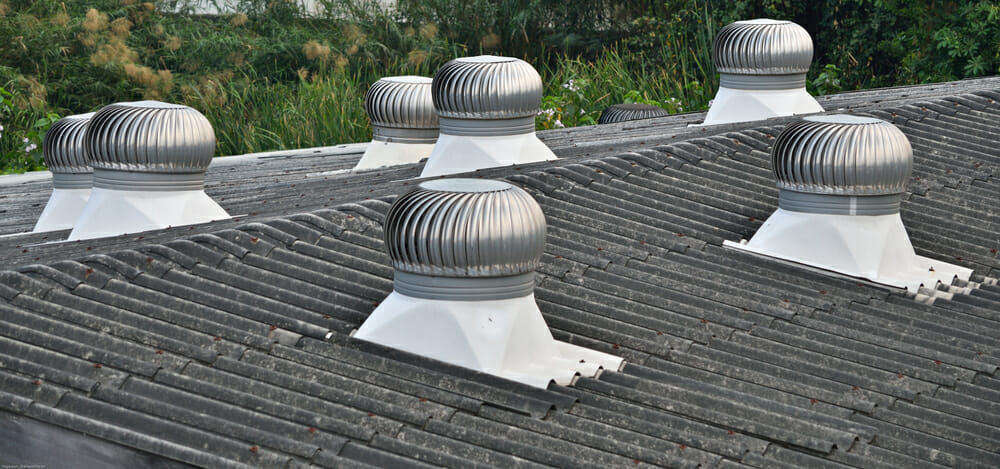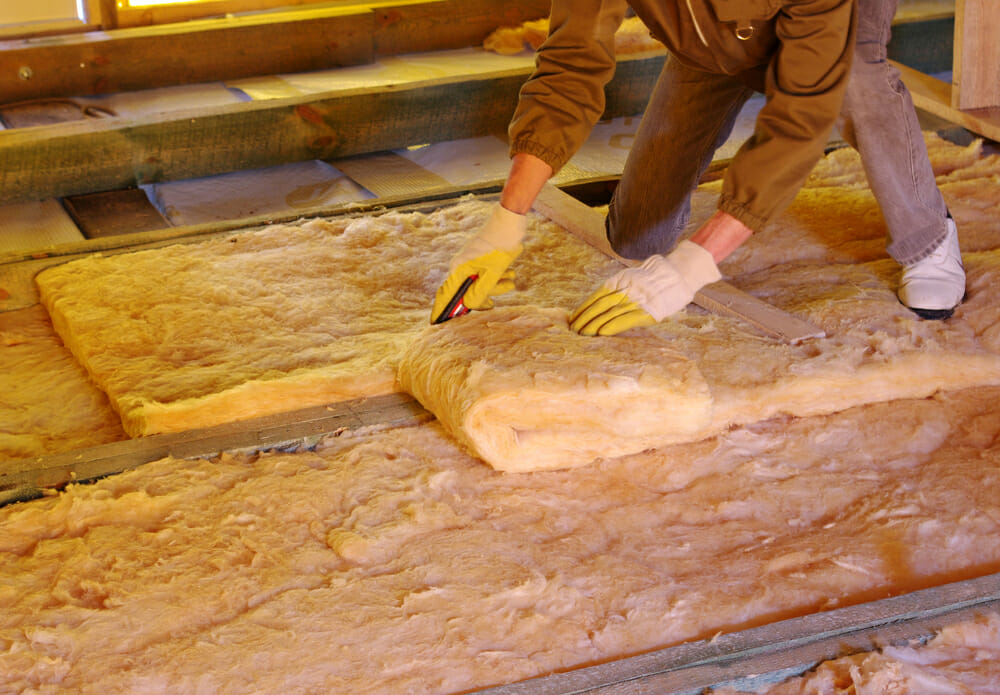Are you doing a solar project?
Modernize can pair you with three to four pros in your area, so you can compare options and save time and money.
When summer temperatures crawl into the triple digits, the last place you want to be is in a hot, stuffy attic. Having a closed-off hot box in your home can’t be good for your heating and cooling, can it? Wouldn’t it be great if you could vent that air and remove it from your home altogether? Solar-powered attic fans might be your solution!
Solar-powered ventilators were designed to solve this problem, keeping attics cooler, and thus lowering overall energy costs. But solar attic fans remain controversial among building professionals, since there’s no clear consensus on how effective they are or whether or not they’re safe to use in every home. Here are the ins and outs of these machines, and how they differ from other home ventilation systems.

Powered Ventilators: A Brief History
Before we get into the specifics of solar-powered roof vents, let’s talk about attic ventilation. Attic ventilation may not make for thrilling cocktail party conversation, but it’s nonetheless an important part of whole-home health. Still, just how important and what kind is best are matters of some speculation among home experts.
The powered ventilator enthusiasts say that these devices can extend the life of your roof, decrease mildew in your attic, make your home less susceptible to mold, and reduce ice buildup during wintry weather. The goal of powered ventilation systems is to reduce heat gain across the ceiling and roof, and to keep moisture from condensing there. Both of these are important, since the majority of American homes experience excessive humidity. Keeping attics dryer and well-ventilated will stabilize the temperatures in the roof, which reduces the chance of rot, asphalt deterioration, and mold.
But not everyone agrees with these claims. Some roofing professionals say that instead of lowering attic temperatures, powered ventilators bulk up energy expenses by sucking cooled air out of the home — and funneling electricity off the grid to get it done. Meanwhile, anytime you increase the amount of openings in your roof, as you must to install a powered ventilator, you increase your vulnerability for leaks, which can counteract the moisture-reducing positives of powered ventilation.
Building research and oversight groups generally believe that more studies need to be performed before we can back up or dismiss temperature and humidity claims. That’s because most initial studies in this area had flaws, like leaky duct work, or limits due to time constraints or weather conditions. A more measured approach is to consider your home’s ventilation system like you would its heating and cooling — it should match the size and demand of your individual home.
What Exactly Is a Solar-Powered Ventilator?
Part of the disagreement about ventilation systems and attic fans has to do with confusion over terms. What’s the difference between whole-house attic fans and powered attic ventilators? A solar-powered roof vent combines elements of both an attic fan and a traditional roof vent. It’s a type of powered attic ventilator that operates using solar energy, offering an energy-efficient solution to attic ventilation.
Attic fans are designed to help cool homes at night. Working with large passive vents in rooftops, they draw warmer indoor air up into the attic where it can be exhausted through the roof vents. The homeowner leaves downstairs windows opened to allow cool nighttime air to flood in, which lowers energy expenses.
Powered ventilators, on the other hand, are not home cooling systems, but they get confused with with whole-house attic fans because they are also fans, technically, and because their goals are similar: to reduce the overall cooling demand in your home, lower energy consumption, and ventilate your attic. But instead of cooling your entire home, powered ventilators exhaust hot, humid air from your attic. The idea is that this will allow cooled outdoor air to fill your home through soffit vents. The ventilation system is attached to a thermometer, which turns the fan on and off when the heat in the attic rises above a certain temperature.
Sounds pretty good, right? Unfortunately, there are lots of variables in homes that can throw this equation off. If your attic isn’t properly sealed, the ventilator may pull air conditioned air through gaps and suck it out to the outdoors, which increases heat in the home, rather than reducing the need for air conditioning. The ventilator can also depressurize the attic interior — which has, in some findings, been shown to increase carbon monoxide throughout the home by allowing water heaters to backdraft.
Find the Right Contractor for Your Solar Project
Whether you’re ready to begin your project now or need some expert advice, our network of contractors are here to help. With a few simple questions, we’ll find the best local professionals for you
Solar-powered ventilators were invented to counter claims that electrically-powered roof vents were saving energy. Because if fans were powered by natural, clean energy, proponents claimed, then they wouldn’t be sucking energy off the grid and thereby negating any energy savings from better ventilation. Researchers at the Florida Solar Energy Center then tested solar-powered ventilators and found that they did, in fact, have a positive effect on home energy use, and reduced homeowners’ reliance on air conditioning. However, many energy experts still maintain that the savings represented by solar-powered ventilators — about $37 annually — are not enough to recoup the price of the equipment, which averages around $850 after installation labor costs.

So, Are Solar-Powered Attic Fans or Roof Vents Really Worth It?
Like many green home renovations, the answer is: it depends. Certainly they’re not recommended if you have combustion gas appliances, like gas-powered water heaters, since the potential for backdrafts in these homes is high. But if your goal is to make your home as energy efficient as possible, regardless of the cost, they may be a positive addition. This is particularly true if you’d like your attic to be cooler — for instance, if you’re storing valuables there that won’t stand up well to high heat and humidity.
Additionally, if you live in a home that suffers from excessive heat in the attic, installing a solar-powered attic fan or ventilator is one potential solution to reduce interior temperatures and protect your roof.
How Else Can I Cool My Attic and Optimize My HVAC?
If your attic is stuffy, humid, or excessively hot, a powered ventilator isn’t your only option. In fact, a well-designed passive ventilation system may do the job just as well. To allow for adequate air flow, about half of the vents should be placed high on the rooftop — at the topmost peaks — and half should be placed in the lower portion of the roof. This creates natural circulation, allowing the hottest air to rise through the higher vents.
Proper insulation and sealing can help out, too. Filling cracks in the ceiling will keep cooling from seeping into unconditioned attics. After these areas have been sealed up, work on adding insulation to the attic floor.
If your home’s HVAC runs throughout the attic, you’ll see better performance if you move the ductwork to your home’s interior, as well — that way you generally won’t have to worry about how hot the attic gets. Make sure the seals between ducts are properly closed to keep heating and cooling from leaking for your system.
These changes will increase the efficiency of your home’s HVAC all throughout the year, not just through the hottest months.
But if you were drawn to solar ventilators because the idea of moderating your roof temperatures sounds appealing, there are some low-tech solutions to keep temperatures down. Consider using lighter colored roof tiles, since darker roofs will absorb a lot more heat. And lastly, think about planting a few trees around your home — you’ll get long lasting benefits that include a shadier roof, and you’ll beautify your home, as well!
Find the Right Contractor for Your Solar Project
Whether you’re ready to begin your project now or need some expert advice, our network of contractors are here to help. With a few simple questions, we’ll find the best local professionals for you
Reviews from Real Homeowners
Welcome to Homeowner Resources! We are the Modernize blog. Modernize pairs more than 3 million homeowners a year with pre-vetted contractors in their area. This blog started because we believe homeowners should know everything about their homes, from how their HVAC works to which front door colors they might love. On Homeowner Resources, you can find information on every part of your home, right down to how you can negotiate with contractors to get the best price. Here's more about the blog.
Need a contractor? Learn more about how Modernize finds the right pro for you.


